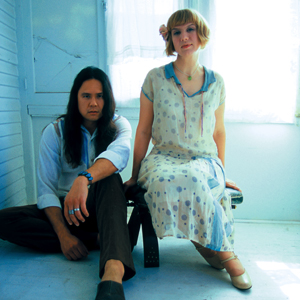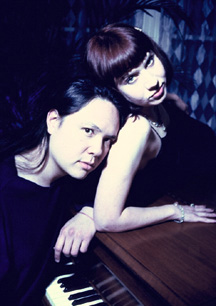March 13, 2006: Music Tap, Matt Rowe
“Honey and Cool Jazz ‘n’ Rock: An interview with Ryan Lum and Anji Bee of Lovespirals”
Matt: Ryan – Anji’s voice is hauntingly memorable; her voice sticks in my mind long after I heard the songs. Are you as hypnotized by her ability to mesh with your vision of how Lovespirals songs should be communicated as we are hearing it?
Ryan: Yeah, it’s surprising how her voice just fits perfectly. I’m very lucky. Her voice has been as important as anything in the evolution of our music together.
Matt: Anji, obviously you are an excellent fit with Lovespirals. The forward progression of the band incorporates you better than many bands undergoing a shift in style. How do you feel your involvement with Lovespirals changes the band? Have you brought your own influences into the structure of the band’s musical vision?
Anji: It would be impossible for me not to bring my own influences into the band, since we are a collaborative team. I think I bring an earthier element to the music. My vocals are very lyrically based, as opposed to Suzanne’s more non-verbal stylings, and my sound is more soulful compared to her purely ethereal sound.
Matt: Where do you draw inspiration from when you write songs? Do songs come easily or do they have to be coaxed from you?
Ryan: Every song comes about in its own way. But generally the main musical idea for a song comes pretty easily. The polishing of that idea into a recorded song though is more of an effort, mainly because we want our new baby to be very good.
Anji: I have found it is impossible to “coax�” Ryan into making music. But once he does get inspired, he’ll work for hours and days non-stop until a song is complete. He gets very annoyed if anything pops up to prevent him from working on music.
As far as my inspiration goes, I would have to say that it just comes from my life experiences. Most times I write lyrics long before any music has begun, but occasionally I write lyrics specifically in relation to some music. Generally the vocal melody is inspired by the music, though sometimes my original melody fits the music as-is.
Matt: How long does it take for a Lovespirals song to birth, from initial inspiration to completed (but not yet recorded) structure at the demo or rehearsal level?
Ryan: Once I have an idea that we’re into, we’ll work on getting it’s structure down; stuff like where they lyrics go and how the song flows from beginning to end. that’s pretty quick work, about an hour or two, but it’s not too much of a song at that moment. A song really starts to take life once I start laying down a few tracks.
Anji: We don’t really rehearse� music per se. We’ll spend some time going through the song with just guitar and vocals, figuring out the whole verse/chorus/bridge arrangement and then go into the studio to begin work on it.
Matt: Typically, how many versions of a song come forth before the perfect one is settled on? Often, you’ll hear slow demos on what eventually becomes faster songs, or vice versa. Does that happen for Lovespirals?
Ryan: Not really. If anything, on a few occasions we’ve gone back and put in better drums, as we did with the title track to Free & Easy as well as the album closer “Sandcastles,”� which resulted in better, stronger songs. Typically though, we try our best to get things sounding good from the start. Experience may be helping me out some with that.
Anji: The creation of Free & Easy was a little different from Windblown Kiss in that we began our second album by reworking a few songs that we held off of the first one. The songs sound basically the same now, as far as tempo and vibe, they’re just recorded better. The only song that might seem to be a new version is “Hand in Hand,”� which was partially inspired by one of the first tracks we ever did together, back in 1999. We reused a sax sample and I fleshed out the vocal lines from the previous recording, but otherwise, all of Ryan’s music is completely different. So it has the same name and some similar vocals, but is really a totally new song.
Matt: What are the recording sessions like? Give us a slice of your recording process especially when an album is in bloom.
Anji: Our general workflow is this: after our initial song inspiration and jam session, we’ve figured out the chord changes and where the lyrics all fit in so that Ryan can fire up ProTools and lay down the basic guitar track. At that point, he needs to figure out a bassline and percussion. After he’s got that worked out, I go in to lay down a vocal. Sometimes this ends up just being a scratch track, but other times it’s the final vocal. Then Ryan is inspired to start adding in additional layers of music, which could be keyboard or more guitar. After that, we check out the vocals again. Sometimes I want to redo them, other times I just want to add harmonies to them. We might go back and forth, adding lushness to the production here and there until we feel that it’s complete.
Matt: Anji, Do you continually write songs?
Anji: It seems to go in cycles for me, where I’ll have a lot of lyrical inspiration and then a slower period hits, and then another bout of inspiration begins again. I try to note anything I come up with for future use, either written in journals or recorded somehow.
Matt: Ryan – What is your musical background? You have great skill in several instruments. Were you schooled as a young child or did you pick up each instrument on your own?
Ryan: I had guitar lessons for several years when I was in elementary and middle school. And I’ve studied music and guitar on and off again at different times in my life. As for piano, I can get by, especially if I am not playing live. I usually know what chords or notes I want, but I usually don’t find the best combinations until i go back and edit what I recorded.
Matt: Ryan – From the Projekt phase of your career, do you have a favorite LSD album? (Why?) A least liked album? (Why?)
Ryan: That’s hard to say. If it had to pick a favorite, perhaps Flux, our last one. Why? It’s got a little more soul than the others and it’s not recorded as badly as the others. I also think it’s cool that I crossed ethereal dream pop with atmospheric drum and bass.
For the full interview, please see musictap.net.
 [audio:http://media.podshow.com/media/4489/episodes/86572/shamelessplugcast-86572-11-08-2007_pshow_202369.mp3]
[audio:http://media.podshow.com/media/4489/episodes/86572/shamelessplugcast-86572-11-08-2007_pshow_202369.mp3]
 Lovespirals are the featured artist on this week’s
Lovespirals are the featured artist on this week’s 

